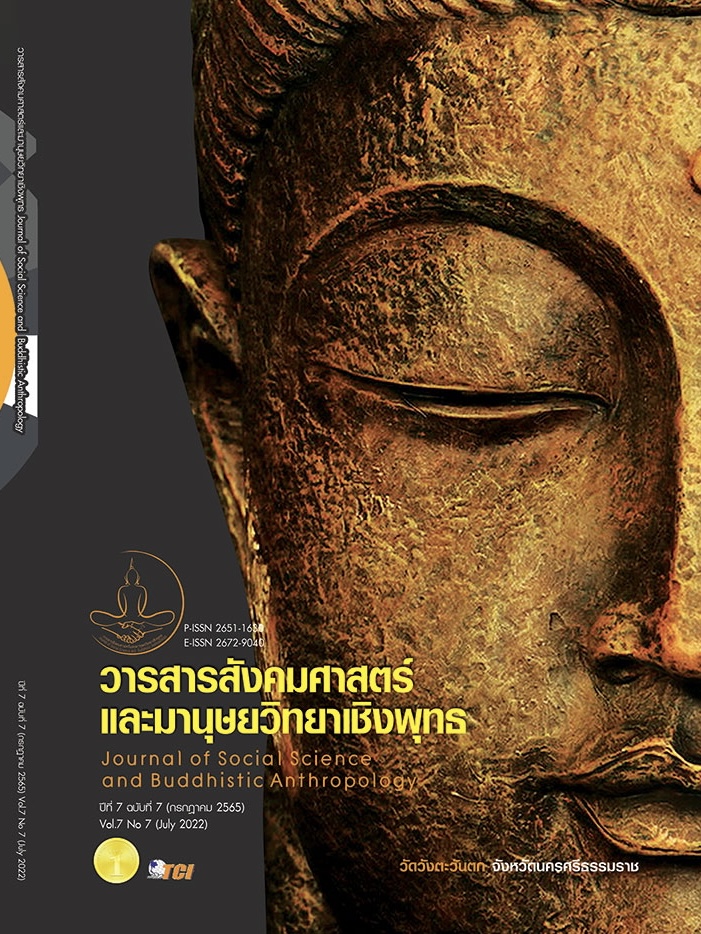STRATEGIES OF LANGUAGE USE AND BELIEF IN LI- KE -PA PLAY AT RUAMMITR PRADITSILPA TROUPE, SURAT THANI PROVINCE
Keywords:
Strategy of Language Use, Belief, Li – Ke - Pa Play, Ruammitr Praditsilpa TroupeAbstract
The Objectives of this research article were to study the strategies of the language use and the belief shown in Li – Ke - Pa play at Ruammitr Praditsilpa Troupe, Surat Thani. It was the qualitative research technique by collecting the data from documents, videos, and field trips at Li – Ke - Pa Culture Learning Center. The informants consisted of 7 Li – Ke - Pa players along with field observation. The research results were that there are 5 aspects of the strategy of its language use including the language use of Li-Ke-Pa songs can be classified into 4 types such as personal pronouns epithet nouns dialect words and superlatives, the use of rhetorical questions which were frequently found in flirtation scenes to show the confidence or to speak sarcastically to the lover, the use of antonym meaning of words which showed the humble manner in order to ask for the audiences’ kindness, and the use of viewing which showed the confidence and the expectation to the play. The idioms were used to explain the meaning and emphasize the understanding of the songs. The 5 aspects of belief in Li-Ke-Pa play were the belief of sacred power and praying to the sacred power Kru Li Ke is specified to make the performance smooth, the belief of trekking traces, the belief of karma and laws of karma, the belief of life living, and the belief of Thai social value. The study showed that its language use contained the beliefs that leaded to the successful and smooth play and became the audiences’ favorite play.
References
กิ่งแก้ว อัตถากร. (2519). คติชนวิทยา. เอกสารนิเทศการศึกษาฉบับที่ 184. กรุงเทพมหานคร: หน่วยศึกษานิเทศก์.
เฉิดฉันท์ ดอกแก้ว. (2543). การวิเคราะห์เนื้อหาของลิเกลูกบท. ใน วิทยานิพนธ์ศิลปะศาสตร มหาบัณฑิต สาขาวิชาไทยศึกษา. มหาวิทยาลัยรามคำแหง.
ณฐ อังศุวิริยะ และคณะ. (2563). กลวิธีการใช้ภาษาและความเชื่อในเรื่องความรักที่ปรากฏในบทเพลงไทยสากลปัจจุบัน. วารสารนานาชาติ มหาวิทยาลัยขอนแก่น สาขามนุษยศาสตร์และสังคมศาสตร์, 10(2), 156-182.
ทรัสตี ก่อสกุล. (2557). ดนตรีประกอบการแสดงลิเกป่าคณะรวมมิตร ประดิษฐ์ศิลป์ อำเภอพุนพิน จังหวัดสุราษฎร์ธานี. ใน วิทยานิพนธ์ศิลปศาสตรมหาบัณฑิต สาขาวิชาดนตรีชาติพันธุ์วิทยา. มหาวิทยาลัยเกษตรศาสตร์.
พงศ์ศักดิ์ สังขภิญโญ. (2543). รายงานวิจัยการศึกษาความเชื่อในบทเพลงสุนทราภรณ์. นครศรีธรรมราช: สถาบันราชภัฏนครศรีธรรมราช.
เรณู โกศินานนท์. (2540). การแสดงพื้นบ้านในประเทศไทย. (พิมพ์ครั้งที่ 5). กรุงเทพมหานคร: ไทยวัฒนาพานิชจำกัด.
ศุภมน อาภานันท์. (2554). การแสดงลิเกคณะทวีป-ชัยณรงค์ วงศ์เทวัญ : การศึกษาตามแนวชาติพันธุ์วรรณนาแห่งการสื่อสาร. ใน วิทยานิพนธ์อักษรศาสตรมหาบัณฑิต สาขาวิชาภาษาไทย. มหาวิทยาลัยศิลปากร.
สมสวัสดิ์ เตชพฤธินันท์. (2557). ความรู้ ความเชื่อ และพฤติกรรมเรื่องกฎแห่งกรรมของนักเรียนมัธยมศึกษาตอนปลายในกรุงเทพมหานคร. ใน วิทยานิพนธ์ปริญญาวิทยาศาสตรมหาบัณฑิต สาขาวิชาสถิติประยุกต์และทคโนโลยีสารสนเทศ. สถาบันบัณฑิตพัฒนบริหารศาสตร์.
สุรพล วิรุฬห์รักษ์. (2522). ลิเก. กรุงเทพมหานคร: โรงพิมพ์ห้องภาพสุวรรณ.
อมรา ประสิทธิ์รัฐสินธุ์. (2542). ภาษาศาสตร์สังคม. กรุงเทพมหานคร: จุฬาลงกรณ์มหาวิทยาลัย.
Downloads
Published
How to Cite
Issue
Section
License
Copyright (c) 2022 Journal of Social Science and Buddhistic Anthropology

This work is licensed under a Creative Commons Attribution-NonCommercial-NoDerivatives 4.0 International License.








